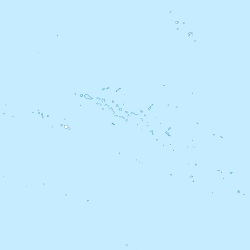Hane (Marquesas)
|
French Polynesia Hane |
||
|---|---|---|
|
|
||
| Coordinates | 8 ° 55 ′ S , 139 ° 32 ′ W | |
| Basic data | ||
| Country | France | |
| Overseas local authority | French Polynesia | |
| ISO 3166-2 | FR-PF | |
|
Bay of Hane
|
||
Hane is the largest settlement on the island of Ua Huka , in the Marquesas in French Polynesia . Hane also has a notable archaeological site. It is only 4 km as the crow flies from the main town of Vaipae'e (road: 10.6 km).
geography
The place is on the south coast of Ua huka, east of the main town Vaipae'e and 5.7 km from the airport . To the east is the village of Hokatu . The mountain Hitikau (884 m) is northeast of the place, which is set back from the main line of the coast at the end of the Hane Bay . In the bay is the Motuhane cone .
Archaeological sites
The archaeological sites of Tehavea and Meiaute are only a few minutes' walk from today's village. The area was first examined by Yosihiko H. Sinoto in 1964–65 . His excavations uncovered more than 12,000 bird bones, of which about 10,000 belonged to about seven different types of shearwater and tube noses . In the course of the archaeological excavations, shards were also found under a layer of stone and originally dated between 300 and 600 AD. Investigations with the radiocarbon method , however, indicate a settlement period between 900 and 1200 AD.
Further research was undertaken at Hane from the 1990s and continued for over 20 years. The 2009 excavations proved that the archipelago's oldest settlement was around AD 1000, with people depending on the resources of the sea. Around 1200 there was a change in the way of working, from then on the buildings, which were still built from perishable materials, were erected on a stone pedestal . The site was later abandoned when people moved into the valleys and from 1200 to 1400 the coastal strips, including Hane, were used as burial grounds.
Attractions
The Le musée de la Mer is exhibiting traditional fishing equipment, fishhooks, fishing techniques, a collection of canoes and also leads a workshop. Auberge Hitikau is a small hostel and restaurant named after the mountain. A local specialty are omelettes made from kaveka (black tern) eggs .
Individual evidence
- ^ Bill Goodwin: Frommer's Tahiti and French Polynesia . John Wiley & Sons, November 2, 2010, ISBN 978-0-470-94738-8 , p. 248.
- ^ Stanley 2004: 279.
- ↑ Marjorie L. Reaka-Kudla, Don E. Wilson, Edward O. Wilson: Biodiversity II: Understanding and Protecting Our Biological Resources . Joseph Henry Press, September 30, 1996, ISBN 978-0-309-52075-1 , p. 150.
- ^ David W. Steadman: Extinction and Biogeography of Tropical Pacific Birds . University of Chicago Press, October 15, 2006, ISBN 978-0-226-77142-7 , pp. 242-.
- ^ William R. Dickinson: Temper Sands in Prehistoric Oceanian Pottery: Geotectonics, Sedimentology, Petrography, Provenance . Geological Society of America, Jan. 1, 2006, ISBN 978-0-8137-2406-5 , pp. 38-39.
- ↑ Dr. Guillaume Molle: 'Bones and Sand': Archeology of the Dunes in Marquesas Islands, French Polynesia . University of French Polynesia. Archived from the original on June 26, 2015. Info: The archive link was inserted automatically and has not yet been checked. Please check the original and archive link according to the instructions and then remove this notice. Retrieved June 24, 2015.
- ↑ Becca Blond, Celeste Brash, Hilary Rogers: Tahiti & French Polynesia. Ediz. English . Lonely Planet, 2006, ISBN 978-1-74059-998-6 , p. 217.
literature
- David Stanley: Moon Handbooks South Pacific . David Stanley, 2004, ISBN 978-1-56691-411-6 .


